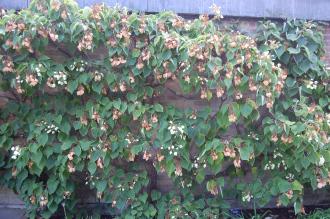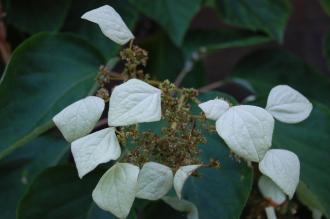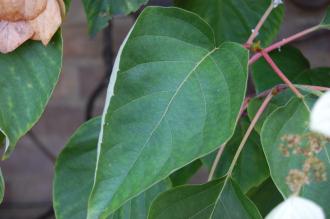
Schizophragma hydrangeoides (18/07/2015, Kew Gardens, London)
Position: Full sun to dappled shade
Soil: Moist, well drained
Flowering period: Summer
Eventual Height: 10m
Eventual Spread: 3m
Hardiness: 5a, 5b, 6a, 6b, 7a, 7b, 8a, 8b
Family: Hydrangeaceae
Schizophragma hydrangeoides is a deciduous climbing shrub with a self clinging habit. Its mid green leaves are ovate with slightly toothed margins, up to 16cm long and 8cm broad. Its leaves turn yellow in autumn before they fall. Its stems are woody and produce aerial roots. Its cream/ white flowers domed corymbs and are up to 25cm across.

Schizophragma hydrangeoides Flower (18/07/2015, Kew Gardens, London)
Schizophragma hydrangeoides, commonly known as Japanese Hydrangea Vine, is native to Japan and Korea. In its native habitat it grows in deciduous woodland, climbing tree trunks.
The etymological root of the binomial name Schizophragma is derived from the Greek schiz meaning phragma meaning ‘screen’. Hydrangeoides is derived from the Greek menaing ‘like a Hydrangea’.
The landscape architect may find Schizophragma hydrangeoides useful as a self clinging climber suitable for lightly shady areas. A ridged structure should be provided for this plant to grow against. This plant prefers a sheltered location with higher air humidity.

Schizophragma hydrangeoides Leaf (18/07/2015, Kew Gardens, London)
Ecologically, Schizophragma hydrangeoides flowers will attract pollinating insects, including bees and butterflies.
The Royal Horticultural Society have given a number of varieties of Schizophragma hydrangeoides their prestigious Award of Garden Merit.
Schizophragma hydrangeoides prefers moist, humus rich, well-drained soils. It tolerates most pH of soil.
Schizophragma hydrangeoides requires little maintenance. Necessary pruning should be carried out in late winter to early spring.

Landscape Architecture

